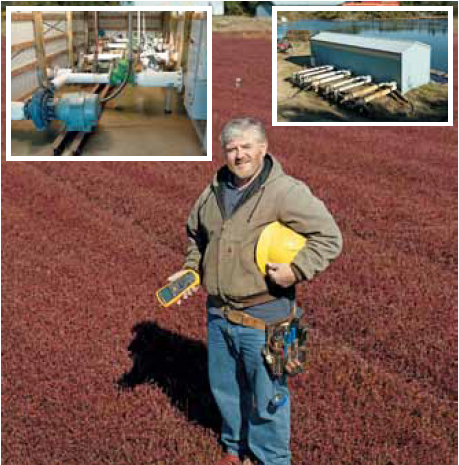Due to the delicate nature of the cranberry, pump failure is not an option.
When a pump or motor fails at Sea Wind Cranberry Farm in Langlois, Ore., farm manager Knute Andersson's business is at stake. An equipment malfunction could allow the farm's cranberry fields to cool just a couple degrees, and on a cold night, that can mean losing part of the crop. For modern cranberry farmers, properly functioning pumps, motors and sprinklers help ensure that their berry yield will be high. Without them, the berries are at the mercy of hostile climates that can cause crop-killing frost or destructive heat.
Because of the fragile nature of the cranberry crop, Andersson needs an on-call electrician who can provide emergency repair service effectively and efficiently enough to save the berries, sometimes in the middle of the night. Even more important, Andersson needs an electrician who can ensure through effective predictive maintenance that many of these emergencies do not happen at all.Andersson's electrician is Joe Buchanan, project lead man and safety chairman at Kyle Electric, North Bend, Ore. Buchanan has been in the electric business 33 years; “since I was a pup,” he says. Throughout that career he has made safety and customer satisfaction his personal mantra.
Buchanan helps keep his customers happy by maintaining and repairing their equipment before it fails. Buchanan has worked with Andersson on the maintenance of the cranberry farms' pump system for about six years.
Berry Particular
Andersson has 11 pump houses, each with between two and five pumps and just as many motors for those pumps. The motors range from 10 to 100 hp. All the fields have temperature sensors that relay back to the pump houses. If the temperature goes up or down too far the pumps come on to start the sprinklers, which then use water to adjust the air temperature in the bogs.
The equipment maintains the proper temperature of the fields 24 hours a day, 10 months a year. The cranberry vines must stay within two or three deg of their ideal temperature, otherwise the crop is damaged and the yield is reduced.
“If they get frosted, they freeze. That's a throw away,” Andersson says. “If it gets too hot, it will cook them, and they will rot on the vine. Yield is all about temperature control.”
While high temperatures are less common in temperate, coastal Oregon, often the air and water on early spring nights can dip dangerously low. If a motor fails then, when the ambient temperature is too high or low, Andersson could lose part or all of an entire field before the pump is up and working again.
Since he started managing the farm in 1991, Andersson has worked on his pump and motor system to maintain the necessary temperature for the berries in his fields. Buchanan began helping him six years ago when he installed the farm's most recent pump house and its four 100-hp motors and pumps at a price of more than $100,000. Each pump can move as much as 1,500 gal of water per minute to provide frost protection, irrigation, weed control and flooding of the bogs at harvest time or when otherwise necessary.

Water, Water, Everywhere
Mother Nature not only provides hazards for the berries, it can also cause abuse to the equipment. Buchanan must be mindful of those hazards during maintenance of the farm's 27 motors. The salt air eats through insulation, and the constant presence of water slowly corrodes the motors and relays. “Windings fail faster. There is corrosion and insulation degradation ahead of schedule,” Buchanan says. However, equipment failure is not an option.
Buchanan has worked to eliminate failure by implementing a predictive maintenance plan. Each winter, he visits the farm for an annual inspection of motors, controls and pumps and checks for loosened terminals and connections and any damage from moisture or age.
On each predictive call, Buchanan is looking for changes in readings, and he checks the insulation and lining around each motor. “We want to prevent critical shut down,” he says. To do this, he compares all his readings against those he measured at the same time the previous year. He also tests for any power dips, looks for any damage to the insulation or the lining of the motor, and ensures that no feedback or deterioration is present.
“We've gone through it all, and it is now pretty much trouble free,” Andersson says. If a problem occurs in any of his pump houses, most commonly, starters burn up or a relay fails.
The Bottom Line
Safety is Buchanan's top priority, and he says that the right tools can make a difference,. “Use quality tools and be a good craftsman.” These tips can not only ensure safety but keep customers coming back, Buchanan says.
Pumps & Systems, September 2010

